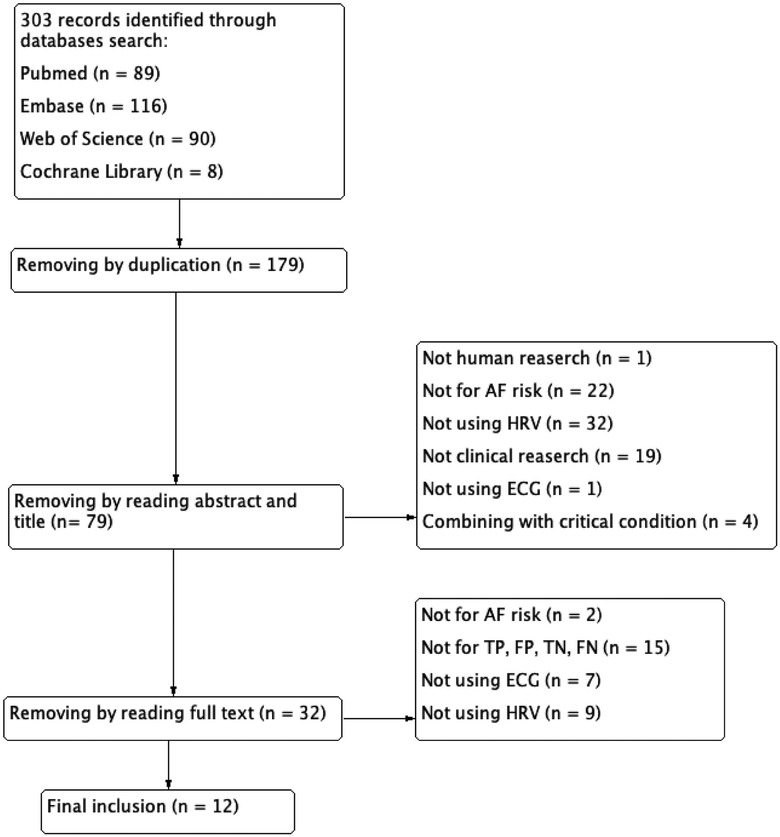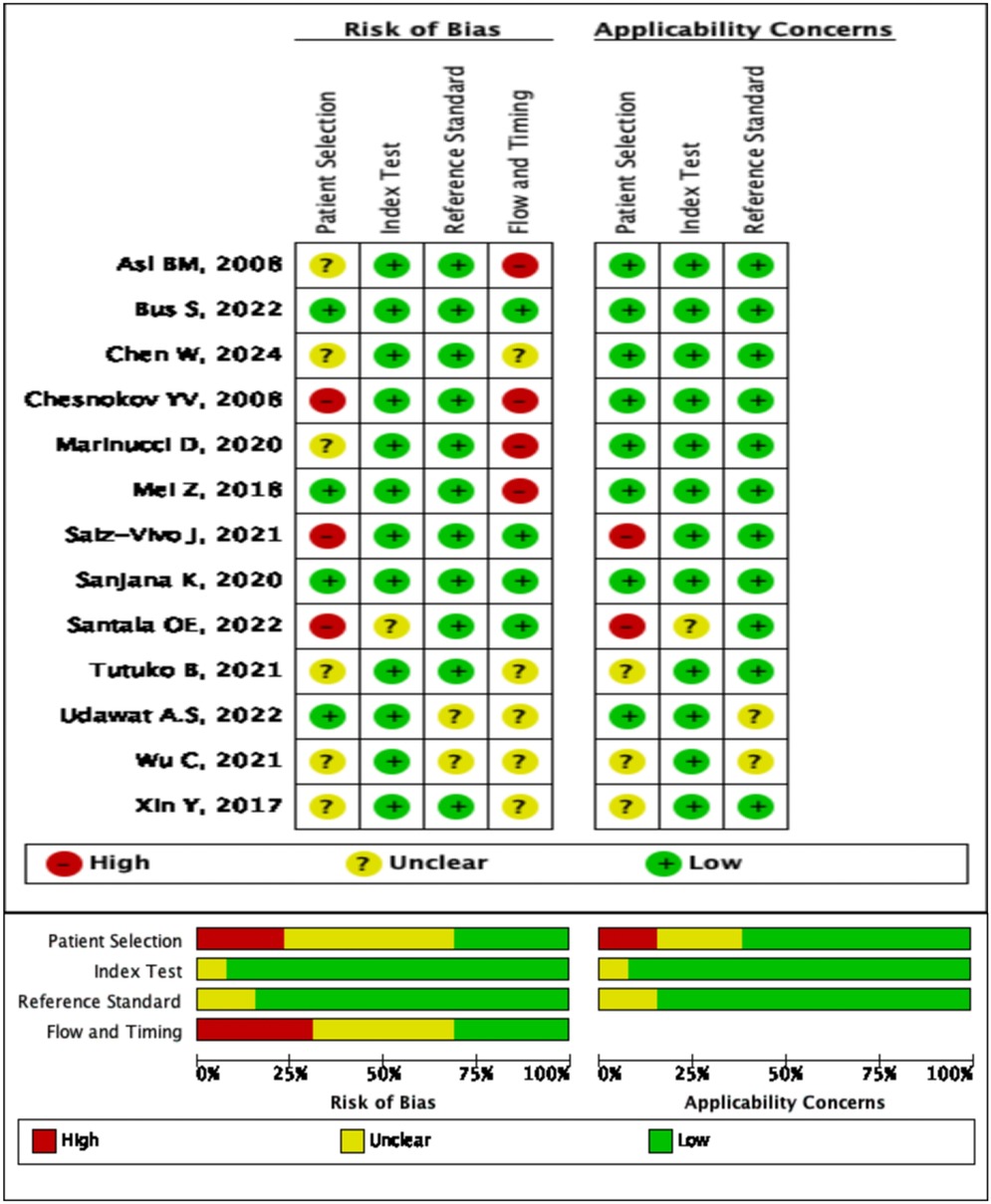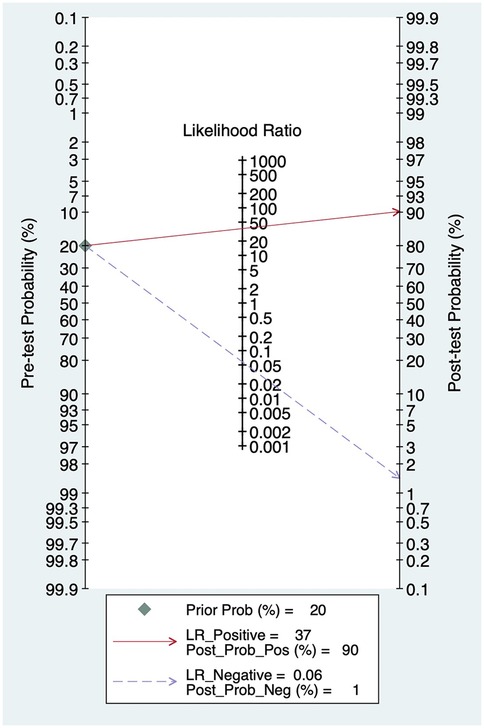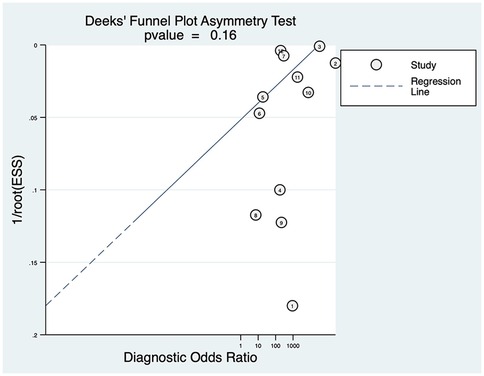- 1Institute of TCM Diagnostics, Hunan University of Chinese Medicine, Changsha, Hunan, China
- 2School of Acupuncture and Tui-na and Rehabilitation, Hunan University of Chinese Medicine, Changsha, Hunan, China
- 3Cardiology Department, The First Hospital of Hunan University of Chinese Medicine, Changsha, Hunan, China
- 4Geriatrics Department, The First Hospital of Hunan University of Chinese Medicine, Changsha, Hunan, China
Background: Atrial fibrillation (AF) is the most common sustained cardiac arrhythmia and is associated with significant cardiovascular complications. Recently, artificial intelligence (AI) algorithms have leveraged heart rate variability (HRV) patterns to enhance the accuracy of AF identification.
Methods: We conducted a systematic review of the literature by searching four major biomedical databases—PubMed, Web of Science, Embase, and Cochrane Library—spanning from their inception to December 13, 2024, following the PRISMA guidelines. We extracted data on true positives, false positives, true negatives, and false negatives from the included studies, which were then synthesized to evaluate sensitivity and specificity comprehensively.
Results: Our final analysis included 12 diagnostic studies. Hierarchical summary receiver operating characteristic modeling revealed excellent discriminative ability, with a pooled sensitivity of 0.94 and specificity of 0.97. In detecting AF, the AI model demonstrated exceptional performance (sensitivity = 0.96, specificity = 0.99, AUC = 1.00). Subgroup analyses revealed that both deep learning algorithms (sensitivity = 0.95, specificity = 0.98, AUC = 0.99) and multi-database studies (sensitivity = 0.96, specificity = 0.97, AUC = 0.99) demonstrated enhanced accuracy in AF identification compared to other approaches.
Conclusion: Machine learning can effectively identify AF with HRV in ECG, especially in diagnosis and detection, with deep learning algorithms and multiple-databases outperforming other diagnostic methods.
Systematic Review Registration: https://www.crd.york.ac.uk/PROSPERO/, PROSPERO (CRD42025634406).
1 Introduction
Atrial fibrillation (AF) is the most common persistent arrhythmia encountered in clinical practice, and its global disease burden continues to increase as the acceleration of aging population (1). Data from the Framingham Heart Study revealed a threefold increase in the incidence of AF over the past 50 years, underscoring its growing impact as a significant public health concern, particularly for the elderly (2). Currently, the clinical diagnosis of AF largely depends on patient-reported symptoms and electrocardiogram (ECG) results. However, existing evidence suggests that these traditional methods are associated with a misdiagnosis rate of approximately 20% (3). This diagnostic uncertainty may result in excessive treatment, increasing patient burdens and inefficient resource allocation. As a result, the development of innovative and accurate diagnostic technologies has become a critical priority to enhance the diagnostic approach for AF.
Heart rate variability (HRV), which quantifies fluctuations in beat-to-beat intervals, has become an established tool in clinical prediction models for sudden cardiac death and life-threatening arrhythmia (4). Notably, recent advancements integrating wearable or implantable HRV data with artificial intelligence (AI)-based analytical systems have facilitated novel strategies for the early detection of AF and precision risk stratification (5, 6).
AI systems replicate human cognitive processes through autonomous decision-making architectures, with their inherent strength rooted in hierarchical pattern recognition and deep processing of complex datasets. In the field of cardiovascular medicine, machine learning (ML)-enhanced ECG interpretation has demonstrated measurable improvements in predictive performance: Alimbayeva et al. established a cardiovascular risk stratification model through multimodal integration of ECG biomarkers using logistic regression, random forest classifiers, and convolutional neural networks (7). While, Khurshid's group developed an ML-driven framework synergizing ECG patterns with clinical risk factors, achieving significant predictive capacity for the onset of AF (8). These developments, driven by ongoing technological advancements and the growing availability of open-access clinical data, positions AI-driven approaches as powerful tools to enhance the accuracy of AF detection and improve diagnostic efficiency.
The increasing clinical adoption of HRV monitoring technologies has driven substantial research interest in AI-driven HRV feature engineering for AF prediction. However, existing studies demonstrate substantial methodological heterogeneity in algorithm architectures, data quality standards, and validation protocols, which may introduce potential biases in diagnostic performance evaluations. This study aims to fill this gap by conducting the first diagnostic test accuracy meta-analysis that simultaneously evaluates both sensitivity and specificity of ML-enhanced HRV analysis for AF detection. The findings provide essential insights to inform clinical decision-making and offer valuable guidance for future algorithmic improvements through standardized performance bench marking.
2 Materials and methods
2.1 Protocol and registration
This meta-analysis is reported according to the Preferred Reporting Items for Meta-Analyses (PRISMA) statement (Supplementary Table S1) (9), and it was registered in the PROSPERO database (CRD42025634406).
2.2 Search strategy and study selection
A systematic search was conducted across four major databases including PubMed, Web of Science, Embase, and the Cochrane Library, from their inception through December 13, 2024, limited to English-language publications. The search strategy is as follows: (atrial fibrillation OR auricular fibrillation) and (heart rate variability OR HRV OR SDNN OR SDANN OR RMSSD) and (artificial intelligence OR machine learning OR deep learning).
Two researchers (YZW and LCX) completed the literature screening separately——title and abstract screening eliminated clearly irrelevant records (e.g., non-AI methods, non-ECG data, or animal studies)——followed by full-text evaluation of potentially eligible articles against predefined criteria. Discrepancies were resolved through consensus discussions or third-reviewer arbitration (LH).
Inclusion criteria were as follows——(1) implementation of machine learning algorithms, (2) using ECG-derived data, (3) AF as the primary clinical endpoint, (4) human clinical studies, and (5) the prediction of true positive (TP), false positive (FP), false negative (FN), and true negative (TN) either be included in studies or can be calculated; Exclusion criteria included——(1) duplication publications, (2) studies involving critically ill populations, and (3) undefined AI methodologies. The complete selection process was detailed in Figure 1.
2.3 Data extraction and quality assessment
Two investigators (YZW and LCX) independently extracted data using standardized templates. The following parameters were collected: first author, publication year, data source, specifications of the AI algorithm, and diagnostic performance metrics (sensitivity, specificity). The methodological quality was assessed with the Quality Assessment of Diagnostic Accuracy Studies-2 (QUADAS-2) tool (10), which evaluates four critical domains: (1) patient selection, (2) index test, (3) reference standard, and (4)flow and timing. After the initial data extraction, cross-validation was conducted to verify inter-rater consistency. Due to the limited sample size (n < 20), Cohen's kappa coefficients were not calculated, as agreement measures can be statistically unstable with small sample sizes.
2.4 Statistical analysis
When a patient was diagnosed as AF, it was considered a positive result; conversely, when diagnosed as non-AF, it was considered a negative result. So, TP refers to the number of true positive samples, which are correctly predicted as positive. FP indicates the number of false positive samples, which are negative but incorrectly predicted as positive. TN refers to the number of true negative samples, which are correctly predicted as negative. FN represents the number of false negative samples, which are positive but incorrectly predicted as negative. Two independent investigators (YZ and LC) extracted the number of TP, FP, FN, and TN from each eligible study. We implemented bivariate random-effects modeling coupled with hierarchical summary receiver operating characteristic analysis to derive pooled sensitivity and specificity estimates with 95% confidence intervals (CI). Heterogeneity assessment incorporated Cochran's Q and I2 statistics, with predefined thresholds: Q-test P-value ≥ 0.10 and I2 ≤ 50% indicating low heterogeneity, vs. P < 0.10 and I2 > 50% denoting substantial heterogeneity. For analyses demonstrating substantial heterogeneity, we conducted meta-regression, sensitivity analyses, leave-one-out analyses. And we conducted subgroup analysis with the type of AI algorithm and number of adopted data sets as parameters to investigate potential sources of variability.
Publication bias was evaluated using Deek's funnel plot asymmetry test, with statistical significance set at P > 0.05 indicating absence of bias. Finally, we conducted a clinical diagnostic test for this diagnostic strategy, calculating both the positive likelihood ratio (PLR) and the negative likelihood ratio (NLR) to assess its diagnostic accuracy. All statistical computations were performed in Stata/MP 18.0 and R 4.4.2.
3 Results
3.1 Characteristics of included studies
This analysis incorporated twelve diagnostic studies (11, 22), five of these studies predicted the occurrence of AF (11, 14, 16, 18, 19), and another seven used AI algorithms to detect AF (12, 13, 15, 17, 20–22). And the included studies with algorithm type distributed as follows: four studies employed DL methods (11, 12, 15, 17), seven utilized ML approaches (13, 14, 18–22), and only one study incorporated both two algorithmic ways (16). Data mainly originated from the PhysioNet platform (https://physionet.org/), MIT-BIH Atrial Fibrillation Database, and MIT-BIH Arrhythmia Database. Only one investigation utilized clinical datasets (18), while another synthesized clinical and repository data (12). Regarding data diversity, only five original studies used multi-source datasets (11–13, 16, 18), other 7 studies relying on single-source one. Comprehensive baseline characteristics were presented in Table 1.
3.2 Quality assessment
The risk of bias in the included studies was evaluated using the QUADAS-2 tool. The evaluation results are as follows: (1) patient election (2 studies with high risk of bias, 6 with unclear risk of bias, and 4 with low risk of bias), (2) index test (all 12 studies with low risk of bias), (3) reference standard (no study with high risk of bias, 2 with unclear risk of bias, 10 with low risk of bias), and (4)flow and timing (4 studies with high risk of bias, 5 with unclear risk of bias, and 3 with low risk of bias). A detailed summary of the quality assessment results can be found in Figure 2.
3.3 Meta analysis
A total of 12 studies were included in the meta-analysis. The forest plot indicated that AI exhibited high diagnostic performance in identifying AF with HRV from ECG. The pooled sensitivity was 0.94 (95% CI: 0.87–0.98), while the pooled specificity was 0.97 (95% CI: 0.92–0.99). The summary receiver operating characteristic curve showed an area under the curve (AUC) of 0.99 (95% CI: 0.97–0.99), with most studies demonstrating strong sensitivity and specificity (Figure 3A). In predicting the onset of AF, the AI algorithm demonstrated a sensitivity of 0.87 (95% CI: 0.74–0.94), specificity of 0.90 (95% CI: 0.72–0.97), and an AUC of 0.94 (Figure 3B). For AF detection, the AI algorithm exhibited even superior performance, with sensitivity of 0.96 (0.87–0.99), specificity of 0.99 (0.96–1.00), and AUC of 1.00 (0.99–1.00) (Figure 3C). The above three results are summarized in Table 2. However, considerable heterogeneity was observed in the forest plot, with sensitivity showing an I2 of 99.95%, Q = 24,113.88, and P < 0.1, and specificity exhibiting an I2 of 99.94%, Q = 18,584.74, and P < 0.1. To explore the sources of heterogeneity, we conducted meta-regression, sensitivity analysis, and subgroup analysis.
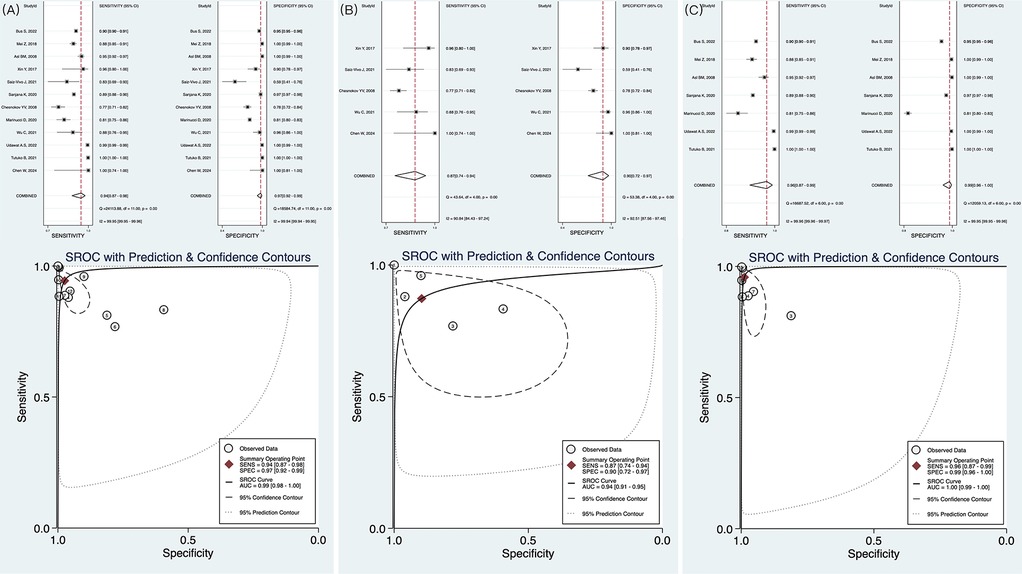
Figure 3. Forest plot and receiver operating characteristics curves of artificial intelligence for AF identification in HRV. (A) The result of pooled research; (B) The results of AI in predicting AF; (C) The results of AI in detecting AF.
3.4 Meta-regression and sensitivity analyses
Meta-regression analyses were performed based on the baseline characteristics of the included studies, focusing on two factors: AI algorithm type and the number of datasets used. The results indicated that the heterogeneity between different AI algorithm types was not statistically significant (P > 0.05), and no significant differences in specificity were observed between single-dataset and multi-dataset groups (P > 0.05). Therefore, neither the AI algorithm type nor the number of datasets explained the heterogeneity observed in the meta-analysis (Supplementary Figure S2). Sensitivity analysis demonstrated the robustness of the overall results (Supplementary Figure S3). When each study was individually excluded, neither the pooled effect size nor the heterogeneity exhibited any significant changes (Supplementary Table S4).
3.5 Subgroup analysis
Subgroup analysis revealed significant differences in diagnostic performance based on various AI algorithms type (Figure 4A). The DL model demonstrated nearly perfect discriminative ability, with an AUC of 0.99 (95% CI: 0.98–1.00), sensitivity of 0.95 (95% CI: 0.76–0.99), and specificity of 0.98 (95% CI: 0.93–1.00) (Supplementary Figure S5A). In contrast, AUC of ML models was 0.97 (95% CI: 0.96–0.98), with sensitivity of 0.92 (95% CI: 0.84–0.96) and specificity of 0.95 (95% CI: 0.84–0.99), which were slightly inferior to those of the DL model (Supplementary Figure S5B). Additionally, data diversity was found to have a crucial impact on model generalization ability (Figure 4B). When trained on a single database, AUC was 0.95 (95% CI: 0.92–0.96), with sensitivity of 0.89 (95% CI: 0.86–0.91) (Supplementary Figure S5C). However, cross-validation using multiple databases significantly improved diagnostic performance, with an AUC of 0.99 (95% CI: 0.98–1.00) and sensitivity increased to 0.96 (95% CI: 0.81–0.99) (Supplementary Figure S5D).
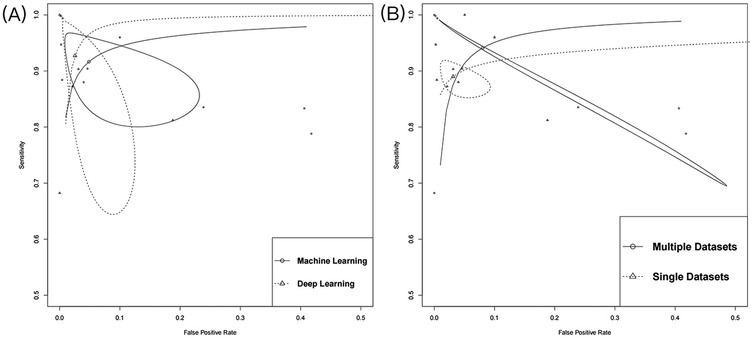
Figure 4. Summary of receiver operating characteristics. (A) The subgroup of algorithm type; (B) The subgroup of number of databases.
3.6 Clinical diagnostic testing
When the PLR value exceeds 10, a positive result significantly raises the likelihood of disease, shifting the pre-test probability from 20% to 90%. In this study, PLR was 37, suggesting this diagnostic marker effectively identified the presence of the disease. Conversely, when the NLR is below 0.1, a negative result markedly reduces the probability of disease, lowering the pre-test probability from 20% to 1%. In this study, NLR was 0.06, demonstrating that this diagnostic marker is highly effective in ruling out the disease in negative cases (Figure 5).
3.7 Publication bias
Publication bias was evaluated using Deek's funnel plot asymmetry test. The results indicated a P-value of 0.16, suggesting that no publication bias was present in the studies included in this analysis (Figure 6).
4 Discussion
This study is the first to evaluate the diagnostic performance of HRV based on AI algorithms through a meta-analysis. The 12 included studies demonstrate that AI models exhibit outstanding performance in identifying AF, especially in detecting AF. The area under the summary receiver operating characteristic curve is the theoretical optimal value (AUC = 1.00), which seems to mean that AI could be the “gold method” for diagnosing AF. Notably, the clinical applicability analysis further validated the diagnostic value of this technology: the PLR value is 37, and the NLR value is 0.06. These findings indicated that the AI-based HRV diagnostic tool has strong accuracy and rule out negative results effectively, highlighting its potential as a auxiliary tools for clinicians in identifying AF.
Our results are consistent with previous studies. For example, Manetas-Stavrakakis et al. conducted a cohort or case-control study using single-lead ECG to detect AF and reported a combined sensitivity of 92.3% and specificity of 96.2% (23). In comparison, our study found even higher sensitivity and specificity, suggesting that HRV may be a more accurate AF diagnostic marker. Subsequent subgroup analyses revealed that, compared to ML models, DL demonstrated superior diagnostic performance, which aligns with the findings of Solam Lee et al (24). Additionally, Xie C.G. et al. reached similar conclusions, with the DL model exhibiting significantly higher sensitivity (98.1%) compared to the ML model (91.5%) (25). DL models represent an important category of ML, encompassing algorithms such as deep feedforward neural networks, convolutional neural networks, and deep belief networks. A key feature of these models is their high degree of flexibility. Unlike ML models, the individual representations in DL are not manually designed by researchers but are instead learned from training data (26). Furthermore, DL models learn representations not in a single step, but across multiple layers between hidden layers. More importantly, the subsequent transformations between layers in DL models are non-linear, significantly enhancing the model's adaptability. This could explain the superior performance of the DL model observed in our study.
Although this study demonstrates promising combined results, several limitations are unavoidable. On the one hand, limitations stems from the included studies themselves. The majority of studies did not use external validation sets, and the widespread use of a single data source led to significant overlap between model training and validation sets. This overlap may hinder the model's ability to adapt to the complexity of real-world patients and clinical environments, potentially increasing misdiagnosis rates and medical risks. The AUC in detecting atrial fibrillation may imply an overlap between the training sets and test sets, and the lack of real-world external validation may be an important reason why the AUC is perfect. On the other hand, there was considerable heterogeneity observed across studies (sensitivity I2 = 99.95%, specificity I2 = 99.94%). Although meta-regression and sensitivity analyses confirmed the robustness of our findings, this suggested the presence of deeper underlying factors. One major cause of heterogeneity is the differences in the source and quality of the raw data. The majority of the included studies relied on the publicly available PhysioNet database, with only one study collecting clinical data and one combining both clinical and database data. While the standardized collection process of public databases reduces technical bias, it may not fully reflect the complexity of real-world clinical scenarios. Clinical data collection, is often susceptible to background noise (e.g., patients’ movement). Unfortunately, due to the limited number of clinical diagnostic studies, we were unable to perform subgroup analysis to compare the diagnostic performance of database vs. clinical data. Secondly, while all studies focused on HRV as the central feature, there were slight differences in the ECG features of HRV, leading to a lack of a standard procedures for HRV extraction. For example, Chen W. et al. used the RR interval as the HRV feature (11), while Bus S. et al. extracted the pRRx parameter to predict AF (22). Other studies incorporated multiple indicators as HRV features, including DNN, RMSSD, pNN50, and pNN20 (15, 18, 19). These technical variations led to inconsistent model inputs, affecting performance stability. Finally, since ECG signals are highly susceptible to various types of interference during data collection, background noise can obscure the true cardiac electrical activity, thereby affecting the performance and accuracy of AI models. Consequently, most diagnostic studies performed denoising prior to HRV signal input. Removing noise helps preserve crucial ECG signals (27), thereby reducing the rates of both false positives and false negatives. However, subtle AF fibrillation waves could be mistakenly classified as noise and eliminated, resulting in diagnostic bias. Additionally, there are significant differences in signal fidelity and computational efficiency among different denoising methods, which contributes to the substantial heterogeneity observed in this study.
The limitations of this study reflect common challenges in the current field. There is a clear need for standardized data collection processes and high-quality datasets to ensure consistency in data input. Additionally, it is crucial to identify and optimize the most effective HRV features to enhance the specificity of AF identification. More importantly, there is an urgent need for additional prospective studies to assess the real-world applicability of AI prediction models. Despite these challenges, the accuracy of AI models for identifying arrhythmias has already been shown to surpass that of general cardiologists (28). We look forward to the development of more comprehensive databases and more advanced AI algorithms, which can assist clinicians in better diagnosing atrial fibrillation.
5 Conclusion
In conclusion, AI effectively utilizes HRV in ECG signals to detect AF, with its DL algorithms and multi-database approaches demonstrating superior diagnostic performance.
Data availability statement
The original contributions presented in the study are included in the article/Supplementary Material, further inquiries can be directed to the corresponding authors.
Author contributions
ZY: Writing – review & editing, Validation, Visualization, Writing – original draft. CL: Writing – original draft. CX: Writing – review & editing. ZN: Writing – review & editing. JW: Writing – review & editing, Methodology. WZ: Writing – review & editing, Supervision. HL: Writing – review & editing, Supervision.
Funding
The author(s) declare that financial support was received for the research and/or publication of this article. This work was supported by the grants of Leading Research Program of Hunan University of Chinese Medicine (No.2022XJJB002), Science and Technology Innovation Program of Hunan Province (No. 2022RC1021), Key project of the Joint Fund of Hunan University of Chinese Medicine (2024XYLH339), General Project of Health Commission of Hunan Province, Project number (D202303019470).
Conflict of interest
The authors declare that the research was conducted in the absence of any commercial or financial relationships that could be construed as a potential conflict of interest.
Generative AI statement
The author(s) declare that no Generative AI was used in the creation of this manuscript.
Publisher's note
All claims expressed in this article are solely those of the authors and do not necessarily represent those of their affiliated organizations, or those of the publisher, the editors and the reviewers. Any product that may be evaluated in this article, or claim that may be made by its manufacturer, is not guaranteed or endorsed by the publisher.
Supplementary material
The Supplementary Material for this article can be found online at: https://www.frontiersin.org/articles/10.3389/fcvm.2025.1581683/full#supplementary-material
References
1. Kornej J, Börschel C, Benjamin EJ, Schnabel RB. Epidemiology of atrial fibrillation in the 21st century, novel methods and new insights. Circ Res. (2020) 127(1):4–20. doi: 10.1161/CIRCRESAHA.120.316340
2. Schnabel RB, Yin X, Gona P, Larson MG, Beiser AS, McManus DD, et al. Fifty-year trends in atrial fibrillation prevalence, incidence, risk factors, and mortality in the community. Lancet. (2015) 386(9989):154–62. doi: 10.1016/S0140-6736(14)61774-8
3. Bogun F, Anh D, Kalahasty G, Wissner E, Serhal CB, Bazzi R, et al. Misdiagnosis of atrial fibrillation and its clinical consequences. Am J Med. (2004) 117(9):636–42. doi: 10.1016/j.amjmed.2004.06.024
4. Catai AM, Pastre CM, de Godoy MF, da Silva E, de Medeiros Takahashi AC, Vanderlei LCM. Heart rate variability: are you using it properly? Standardisation checklist of procedures. Braz J Phys Ther. (2020) 24(2):91–102. doi: 10.1016/j.bjpt.2019.02.006
5. Oikawa J, Fukaya H, Ishii S, Nabeta T, Nakamura H, Ishizue N, et al. Variation in heart rate range by 24-h Holter monitoring predicts heart failure in patients with atrial fibrillation. ESC Heart Fail. (2022) 9(5):3092–100. doi: 10.1002/ehf2.14035
6. Matusik PS, Matusik PT, Stein PK. Heart rate variability and heart rate patterns measured from wearable and implanted devices in screening for atrial fibrillation: potential clinical and population-wide applications. Eur Heart J. (2023) 44(13):1105–7. doi: 10.1093/eurheartj/ehac546
7. Alimbayeva Z, Alimbayev C, Ozhikenov K, Bayanbay N, Ozhikenova A. Wearable ECG device and machine learning for heart monitoring. Sensors. (2024) 24(13):4201. doi: 10.3390/s24134201
8. Alahdab F, Saad MB, Ahmed AI, Al Tashi Q, Aminu M, Han Y, et al. Development and validation of a machine learning model to predict myocardial blood flow and clinical outcomes from patients’ electrocardiograms. Cell Rep Med. (2024) 5(10):101746. doi: 10.1016/j.xcrm.2024.101746
9. Moher D, Liberati A, Tetzlaff J, Altman DG, PRISMA Group. Preferred reporting items for systematic reviews and meta-analyses: the PRISMA statement. Br Med J. (2009) 339:b2535. doi: 10.1136/bmj.b2535
10. Whiting PF, Rutjes AWS, Westwood ME, Mallett S, Deeks JJ, Reitsma JB, et al. QUADAS-2: a revised tool for the quality assessment of diagnostic accuracy studies. Ann Intern Med. (2011) 155(8):529–36. doi: 10.7326/0003-4819-155-8-201110180-00009
11. Chen W, Zheng P, Bu Y, Xu Y, Lai D. Achieving real-time prediction of paroxysmal atrial fibrillation onset by convolutional neural network and sliding window on R-R interval sequences. Bioengineering (Basel). (2024) 11(9):903. doi: 10.3390/bioengineering11090903
12. Tutuko B, Nurmaini S, Tondas AE, Rachmatullah MN, Darmawahyuni A, Esafri R, et al. AFibnet: an implementation of atrial fibrillation detection with convolutional neural network. BMC Med Inform Decis Mak. (2021) 21(1):216. doi: 10.1186/s12911-021-01571-1
13. Udawat AS, Singh P. An automated detection of atrial fibrillation from single-lead ECG using HRV features and machine learning. J Electrocardiol. (2022) 75:70–81. doi: 10.1016/j.jelectrocard.2022.07.069
14. Wu C, Hwang M, Huang TH, Chen YMJ, Chang YJ, Ho TH, et al. Application of artificial intelligence ensemble learning model in early prediction of atrial fibrillation. BMC Bioinformatics. (2021) 22(Suppl 5):93. doi: 10.1186/s12859-021-04000-2
15. Marinucci D, Sbrollini A, Marcantoni I, Morettini M, Swenne CA, Burattini L. Artificial neural network for atrial fibrillation identification in portable devices. Sensors (Basel). (2020) 20(12):3570. doi: 10.3390/s20123570
16. Chesnokov YV. Complexity and spectral analysis of the heart rate variability dynamics for distant prediction of paroxysmal atrial fibrillation with artificial intelligence methods. Artif Intell Med. (2008) 43(2):151–65. doi: 10.1016/j.artmed.2008.03.009
17. Sanjana K, Sowmya V, Gopalakrishnan EA, Soman KP. Explainable artificial intelligence for heart rate variability in ECG signal. Healthc Technol Lett. (2020) 7(6):146–54. doi: 10.1049/htl.2020.0033
18. Saiz-Vivo J, Corino VDA, Hatala R, de Melis M, Mainardi LT. Heart rate variability and clinical features as predictors of atrial fibrillation recurrence after catheter ablation: a pilot study. Front Physiol. (2021) 12:672896. doi: 10.3389/fphys.2021.672896
19. Xin Y, Zhao Y. Paroxysmal atrial fibrillation recognition based on multi-scale wavelet α-entropy. Biomed Eng Online. (2017) 16(1):121. doi: 10.1186/s12938-017-0406-z29061181
20. Asl BM, Setarehdan SK, Mohebbi M. Support vector machine-based arrhythmia classification using reduced features of heart rate variability signal. Artif Intell Med. (2008) 44(1):51–64. doi: 10.1016/j.artmed.2008.04.007
21. Mei Z, Gu X, Chen H, Chen W. Automatic atrial fibrillation detection based on heart rate variability a spectral features. IEEE ACCESS. (2018) 6:53566–75. doi: 10.1109/ACCESS.2018.2871220
22. Buś S, Jędrzejewski K, Guzik P. Statistical and diagnostic properties of pRRx parameters in atrial fibrillation detection. J Clin Med. (2022) 11(19):5702. doi: 10.3390/jcm11195702
23. Manetas-Stavrakakis N, Sotiropoulou IM, Paraskevas T, Stavrakaki SM, Bampatsias D, Xanthopoulos A, et al. Accuracy of artificial intelligence-based technologies for the diagnosis of atrial fibrillation: a systematic review and meta-analysis. J Clin Med. (2023) 12(20):6576. doi: 10.3390/jcm12206576
24. Lee S, Chu Y, Ryu J, Park YJ, Yang S, Koh SB. Artificial intelligence for detection of cardiovascular-related diseases from wearable devices: a systematic review and meta-analysis. Yonsei Med J. (2022) 63(Suppl):S93–107. doi: 10.3349/ymj.2022.63.S93
25. Xie C, Wang Z, Yang C, Liu J, Liang H. Machine learning for detecting atrial fibrillation from ECGs: systematic review and meta-analysis. Rev Cardiovasc Med. (2024) 25(1):8. doi: 10.31083/j.rcm2501008
26. LeCun Y, Bengio Y, Hinton G. Deep learning. Nature. (2015) 521(7553):436–44. doi: 10.1038/nature14539
27. Deevi SA, Kaniraja CP, Mani VD, Mishra D, Ummar S, Satheesh C. HeartNetEC: a deep representation learning approach for ECG beat classification. Biomed Eng Lett. (2021) 11(1):69–84. doi: 10.1007/s13534-021-00184-x
28. Chang KC, Hsieh PH, Wu MY, Wang YC, Chen JY, Tsai FJ, et al. Usefulness of machine learning-based detection and classification of cardiac arrhythmias with 12-lead electrocardiograms. Can J Cardiol. (2021) 37(1):94–104. doi: 10.1016/j.cjca.2020.02.096
Keywords: deep learning, machine learning, atrial fibrillation, heart rate variability, ECG, meta-analysis
Citation: Yin Z, Liu C, Xie C, Nie Z, Wei J, Zhang W and Liang H (2025) Identification of atrial fibrillation using heart rate variability: a meta-analysis. Front. Cardiovasc. Med. 12:1581683. doi: 10.3389/fcvm.2025.1581683
Received: 22 February 2025; Accepted: 2 June 2025;
Published: 19 June 2025.
Edited by:
Rui Providencia, University College London, United KingdomCopyright: © 2025 Yin, Liu, Xie, Nie, Wei, Zhang and Liang. This is an open-access article distributed under the terms of the Creative Commons Attribution License (CC BY). The use, distribution or reproduction in other forums is permitted, provided the original author(s) and the copyright owner(s) are credited and that the original publication in this journal is cited, in accordance with accepted academic practice. No use, distribution or reproduction is permitted which does not comply with these terms.
*Correspondence: Hao Liang, bGlhbmdoYW9AaG51Y20uZWR1LmNu; Wen Zhang, NDY4OTAzNThAcXEuY29t
 Ziwei Yin
Ziwei Yin Changxin Liu
Changxin Liu Chenggong Xie
Chenggong Xie Zixing Nie
Zixing Nie Jiaming Wei
Jiaming Wei Wen Zhang4*
Wen Zhang4* Hao Liang
Hao Liang